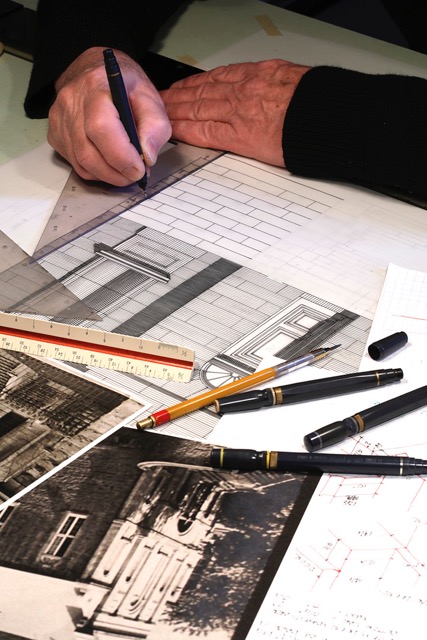
DRAWING/ARCHITECTURE
Peter Lanken, architecte
Andrea Palladio, the great Italian architect of the sixteenth century, wrote : “Guided by a natural inclination, I gave myfelf up in my moft early years to the ftudy of architecture.” I long ago acknowledged Palladio as master and recognized, with him, the importance of examining existing buildings. I became aware of the vast architectural heritage left us by the Catholic church in Quebec. Intermittent examination of old churches gradually revealed that one architect stood out, by reason of his intelligence, from all the others. His name was Victor Bourgeau (1809 – 1888).
Unlike Palladio, about whom whole libraries have been published, and of whose drawings many still exist, there is scant information about Bourgeau. Almost no drawings exist. If I wanted drawings of his work – drawings are essential to an architect’s understanding – I would have to make them myself.
Palladio, again: “I fet myfelf to fearch into the reliques of all the antient edifices, that, in fpight of time and the cruelty of the Barbarians, yet remain; and finding them much more worthy of obfervation, than at firft I had imagined, I began very minutely with the utmoft diligence to measure every one of their parts….”
My formal studies began with the measuring the façades of several of Bourgeau’s churches. Since there is no practical way of taping details 140 feet above the ground, I turned to surveyor’s instruments. At first, I used a theodolite, accurate to six seconds, from two stations; me, I used a surveyor’s Total Station (Sokkia SET5 30R) when it became available to me.
In either case, some 300 points were identified on the façade, and the angular displacement of each was recorded. Using a simple, hand-held calculator (Casio fx-280), the coordinates of each point were trigonometrically calculated. The calculator made the mathematics comparatively easy, although typically 40 or 50 pages of calculations were required. I shudder to think of the time that would have been expended had I only the old printed trigonometric tables to work with.
Once the coordinates were determined, in three dimensions, they were drawn, pencil on paper, at a scale of ¼” to 1’-0”. Accuracy was in the range of ½” to 5/8”, usually comparable to construction tolerances then and now.
Church plans were measured with a tape for small elements (and a dressmaker’s tape for the circumference of columns), and a Leica Disto “Classic a” for longer dimensions. The Disto has the advantage of accuracy – better than a tape – and it can be used by a man working alone. Points on ceilings were projected on the floor with a Hilti PMP34 laser level, and then easily located relative to columns and walls. Their heights were measured with the Disto on the vertical lines given by the Hilti level. Plans – always ceiling plans – were also drawn, pencil on paper, at a scale of ¼” to 1’-0”.
Several drawings have been rendered for presentation, using Rapidograph pens on Mylar.
Palladio:“I grew at laft fo follicitous an examiner, (not finding any thing which was not done with reafon and beautiful proportion) that I have very frequently not only travelled in different parts of Italy, but also out of it, that I might intirely, from them, comprehend what the whole had been, and reduce it into defign.”
“Reduce it into design.” That is, to comprehend the process by which the architect realized his design. With Victor Bourgeau, as with Andrea Palladio, accurate drawings can reveal geometric system by which windows, doors and columns and other construction elements are located. They also allow comparison of details – cornices, capitals, columns – with the rules established by Palladio and others 450 years ago. In other words, good drawings allow one to understand a work of architecture.
Quotations are from The Author’s Preface to the Reader, in Andrea Palladio, The Four Books of Architecture, Isaac Ware, London, 1738; originally published as I Quattro Libri dell’Architettura, Domenico de Franceschi, Venice, 1570.
March 2018
